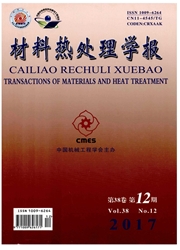

 中文摘要:
中文摘要:
<正>The energetic and electronic structures of precipitates on the Cu-rich side of Cu-Ni-Si alloys were investigated by using the first-principle calculations based on plane-wave pseudopotential method.The negative formation heats and the cohesive energies of these precipitates were estimated with electronic structure calculations, and their structural stability was also analyzed.The results show thatδ-Ni2Si,γ-Ni5Si2 andβ-Ni3Si precipitates all have great alloying ability and structural stability,which,after comparing their density of states (DOS),is found attributed to the pseudogap effect near the Fermi level(Ef)and strong hybridization between the Ni-3d and Si-3p states.Compared with the other two precipitates,theδ-Ni2Si precipitate has the greatest structural stability,which is resulted from its lower DOS at Ef and the main bonding peaks slightly moving to the low energy region.
 英文摘要:
英文摘要:
The energetic and electronic structures investigated by using the first-principle calculations formation heats and the cohesive energies of these of precipitates on the Cu-rich side of Cu-Ni-Si alloys were based on plane-wave pseudopotential method. The negative precipitates were estimated with electronic structure calcu- lations, and their structural stability was also analyzed. The results show that δ-Ni2Si, γ-Ni5Si2 and β-Ni3Si precipitates all have great alloying ability and structural stability, which, after comparing their density of states (DOS), is found attributed to the pseudogap effect near the Fermi level (EF) and strong hybridization between the Ni-3d and Si-3p states. Compared with the other two precipitates, the δ-Ni2Si precipitate has the greatest structural stability, which is resulted from its lower DOS at EF and the main bonding peaks slightly moving to the low energy region.
 同期刊论文项目
同期刊论文项目
 同项目期刊论文
同项目期刊论文
 期刊信息
期刊信息
